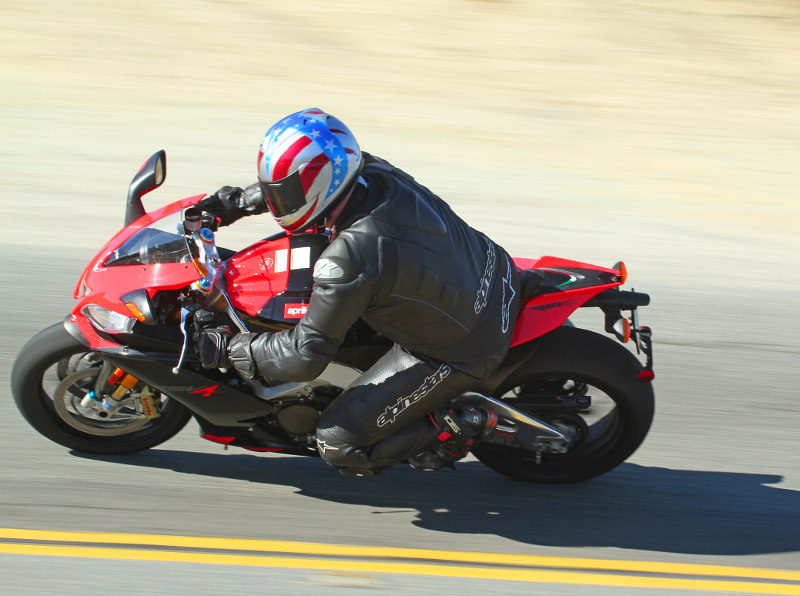Photos By Evan Edge

We have already thoroughly tested Aprilia’s RSV4 Factory on the track. Take a look at that article for all of the technical details and specification of this Italian machine. Although we could hardly be more impressed with the RSV4’s track performance, we wanted to spend some time with the bike in the real world on the streets and roads of Southern California. As we previously commented, it is striking how small this bike is when you first see it, and when you throw a leg over it. The cliche is that the open classer is “as small as a 600”. The reality is that the RSV4 is smaller than some 600s we have ridden. For a 1000cc superbike, it feels tiny.
The next cliche you will hear is that it “handles like a 600”. Feeling light and nimble, the RSV4 changes directions easier than any production superbike we can remember. It is not just how easily this bike changes directions, however, it is the manner in which it does so. There is a fluidity about it… reaching the point fairly quickly where the bike seems to turn as the rider looks around the next bend, and leaving the rider wondering how it happened.
Part of this sensation is surely down to the top drawer suspension components from Ohlins. Our test bike, with the stock suspension settings, soaked up road imperfections very smoothly, exhibiting virtually no stiction. We never touched the settings even though three test riders varried in weight from roughly 180 to 230 pounds. Very good balance front-to-back, and well controlled, minimal dive (on braking) and squat (on acceleration).
Beyond the suspension, Aprilia obviously did a masterful job at mass centralization and weight distribution. Although engine position, swingarm pivot and head angle are all adjustable, it never crossed our minds to touch anything. High praise, indeed, given the skill and experience levels of our three test riders.
Power delivery is essentialy as we found it on the track. In the unlimited “T” position, the RSV4 makes very good power down low and in the midrange, pulling as hard as a Honda CBR 1000RR we had along (after correcting for gearing differences). It is right in the hunt with the best in the category when it comes to power in the middle of the tach (all the way from 4k to 8k). Fuel delivery is extremely good, as well, with smooth transitions from closed-to-open throttle while using all three ignition maps available.

The stout midrange power makes the top-end all the more surprising. From 9k to 13k, the RSV4 is a beast. The top-end rush is certainly competetive with other bikes in the superbike category (which is to say scary-fast, and almost unusable on the street).
Nevertheless, you will want to find excuses to rev this bike. The sound from the narrow angle V4 is special. The engine has a personality, and feel, that go beyond your typical inline four-cylinder. The power delivery and engine pulse provide a great connection between the palm of your throttle hand and the rear wheel, providing confidence that you can control the traction as you put the power down (even without selecting one of the two softer ignition maps, “S” or “R”). Honda and other manufacturers have recognized the emotional appeal provided by a V4 engine, and you will notice it before you reach the end of your driveway the first time you ride this bike.

Braking was strong, but did not provide the best feel. We thought that our test unit might have slightly glazed discs from prior use (abuse?) by other journalists. The gear change is not the easiest, or smoothest, but it did not hamper our riding on the street.
The ergonomics are reasonable for a modern sportbike, with a relatively short reach to the bars, and pegs that are not overly high. This is certainly no sport tourer, however. It is a weapon for speed, just as it should be.
Gabe fell in love with BMW’s S1000RR, but for those of us who rode the Aprilia, it is hard to imagine that the Germans have the measure of the Italians in this small arena. The Aprilia is that good. We hope to bring you a straight-up comparison of the BMW and the Aprilia, shortly.
In the meantime, we do not hesitate to recomend the RSV4 Factory if you like the styling and have the cash (U.S. MSRP $20,990). The “standard” RSV4 R can be had for a more reasonable $15,999. The performance will not disappoint, and that distinctive V4 wail is an added bonus that is hard to value. For aditional details and specifications, visit Aprilia’s website.

MD Readers Respond:
- I applaud KTM’s technological advances evidenced by their foray into electric motors. On a related note: As the owner of a fuel-injected 2008 Yamaha WR250, I will never consider the purchase of a new, normally carbureted motor again, such are the several obvious benefits of injection, especially for someone who lives at 4900′ elevation. I respectfully advise the motor “press” and makers of motorized transport to strongly consider this, especially those such as KTM who strive for the top tier market position. IMO any motor company marketing carburetor “technology” (fully abandoned by the automotive universe several decades ago…annual advances in the world of technology are gargantuan) can not be taken seriously as a “premium” contender. A carbureted motor vehicle is purely and solely an anachronism and nothing more; to the extent the motorized press presents any other viewpoint to their readers (including the motor companies) they summarily fail all concerned parties. James





